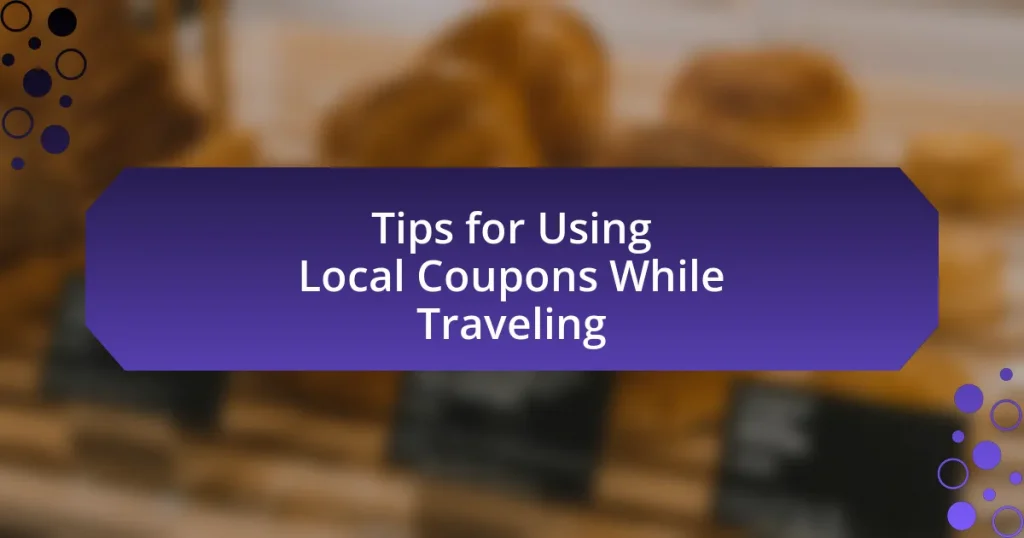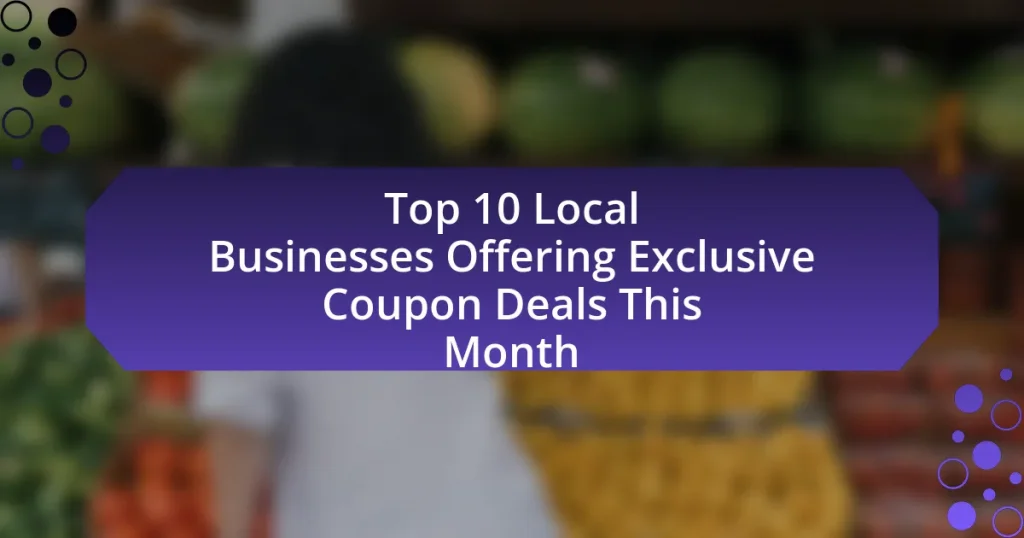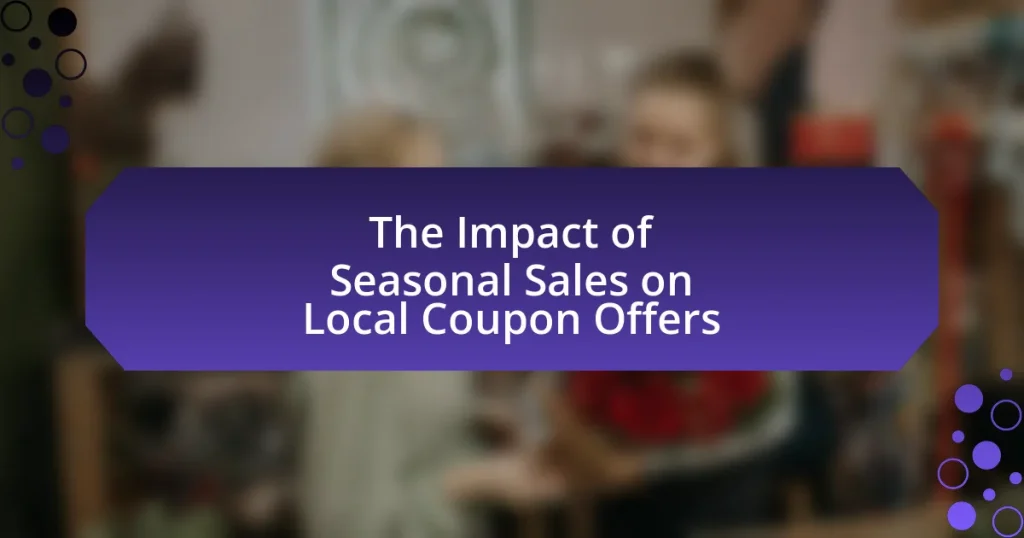The article explores the psychology of couponing, emphasizing the motivations behind consumer behavior related to coupons and local offers. It highlights how consumers perceive coupons as valuable tools for saving money, which activates psychological triggers such as urgency and scarcity, ultimately influencing purchasing decisions. The discussion includes the emotional responses associated with couponing, the impact of demographics on coupon usage, and the role of technology in shaping modern couponing strategies. Additionally, it examines best practices for consumers to maximize savings through local offers and effective coupon organization.

What is the Psychology of Couponing?
The psychology of couponing involves understanding consumer behavior and the motivations behind using coupons to make purchases. Consumers often perceive coupons as a means to save money, which triggers feelings of satisfaction and accomplishment. This perception is supported by research indicating that the act of saving money can activate the brain’s reward system, similar to the pleasure derived from receiving a gift. Additionally, coupons can create a sense of urgency and scarcity, compelling consumers to act quickly to take advantage of limited-time offers. Studies show that the anticipation of saving can enhance the overall shopping experience, making consumers more likely to engage with brands that offer coupons.
How do consumers perceive coupons and discounts?
Consumers perceive coupons and discounts as valuable tools that enhance their purchasing power and influence their buying decisions. Research indicates that 92% of consumers use coupons, demonstrating their widespread acceptance and perceived utility in saving money. Additionally, discounts create a sense of urgency and encourage immediate purchases, as consumers often associate them with limited-time offers. This perception is reinforced by studies showing that consumers feel a psychological reward when they save money, which can lead to increased brand loyalty and repeat purchases.
What psychological triggers are activated by couponing?
Couponing activates several psychological triggers, including scarcity, urgency, and social proof. Scarcity is triggered when consumers perceive limited-time offers, leading to a fear of missing out, which can drive immediate purchasing decisions. Urgency is created through time-sensitive promotions, compelling consumers to act quickly to secure savings. Social proof is activated when consumers see others using coupons or sharing deals, reinforcing the idea that couponing is a popular and accepted behavior. These triggers are supported by research indicating that scarcity and urgency can significantly increase consumer motivation and purchasing behavior, as demonstrated in studies on consumer psychology.
How does the perception of savings influence consumer behavior?
The perception of savings significantly influences consumer behavior by enhancing the likelihood of purchase and increasing brand loyalty. When consumers perceive that they are saving money, they are more inclined to make a purchase, as evidenced by a study from the Journal of Consumer Research, which found that consumers are motivated by the idea of getting a deal, leading to increased spending in the presence of discounts or coupons. This perception not only drives immediate purchases but also fosters repeat business, as consumers tend to return to brands that they associate with savings, reinforcing a cycle of loyalty and continued engagement.
Why are local offers particularly appealing to consumers?
Local offers are particularly appealing to consumers because they provide immediate value and convenience. Consumers often seek deals that are easily accessible and relevant to their daily lives, which local offers fulfill by promoting nearby businesses. Research indicates that 78% of consumers prefer to shop locally when they can save money, highlighting the effectiveness of local promotions in driving consumer behavior. Additionally, local offers foster a sense of community and support for local economies, making them more attractive to consumers who value local engagement.
What role does community connection play in couponing?
Community connection significantly enhances the effectiveness of couponing by fostering trust and loyalty among consumers. When individuals feel a sense of belonging to a community, they are more likely to engage with local businesses and utilize coupons that promote those establishments. Research indicates that 70% of consumers prefer to shop locally when they perceive a strong community connection, as it aligns with their values of supporting neighbors and local economies. This connection not only drives coupon usage but also encourages word-of-mouth promotion, further amplifying the reach and impact of local offers.
How do local offers enhance the shopping experience?
Local offers enhance the shopping experience by providing consumers with immediate financial incentives and fostering a sense of community engagement. These offers often lead to increased foot traffic in local stores, as shoppers are motivated to take advantage of discounts that are geographically relevant. Research indicates that 79% of consumers are more likely to shop at a local business if they receive a coupon or discount, demonstrating the effectiveness of local offers in driving sales and customer loyalty. Additionally, local offers create a personalized shopping experience, as they often reflect the preferences and needs of the community, making consumers feel more connected to the businesses they support.
What are the emotional responses associated with couponing?
Couponing elicits a range of emotional responses, primarily including excitement, satisfaction, and a sense of accomplishment. Consumers often experience excitement when discovering discounts, which can trigger a dopamine release, reinforcing positive feelings associated with saving money. Satisfaction arises from the perceived value gained through couponing, as individuals feel they are making wise financial decisions. Additionally, a sense of accomplishment is frequently reported when successfully using coupons, as it can enhance self-efficacy and control over personal finances. Research indicates that these emotional responses can lead to increased consumer loyalty and repeated coupon usage, further solidifying the psychological benefits associated with couponing.
How does couponing affect feelings of satisfaction and accomplishment?
Couponing enhances feelings of satisfaction and accomplishment by providing consumers with a tangible sense of savings and value. When individuals successfully use coupons, they often experience a boost in self-efficacy, as they perceive themselves as savvy shoppers who can maximize their resources. Research indicates that this behavior is linked to positive emotional outcomes; for instance, a study published in the Journal of Consumer Research found that consumers who engage in couponing report higher levels of happiness and fulfillment due to the perceived financial benefits and the thrill of finding deals. This sense of achievement reinforces the behavior, creating a cycle where the act of couponing becomes associated with positive emotional states.
What impact does couponing have on consumer loyalty?
Couponing significantly enhances consumer loyalty by incentivizing repeat purchases and fostering brand attachment. Research indicates that consumers who utilize coupons are more likely to develop a preference for brands that offer them, as they perceive greater value and savings. A study published in the Journal of Retailing found that 60% of consumers reported increased loyalty to brands that provide coupons, highlighting the effectiveness of this strategy in building long-term relationships. Additionally, couponing creates a sense of urgency and exclusivity, further encouraging consumers to return to the brand for future purchases.
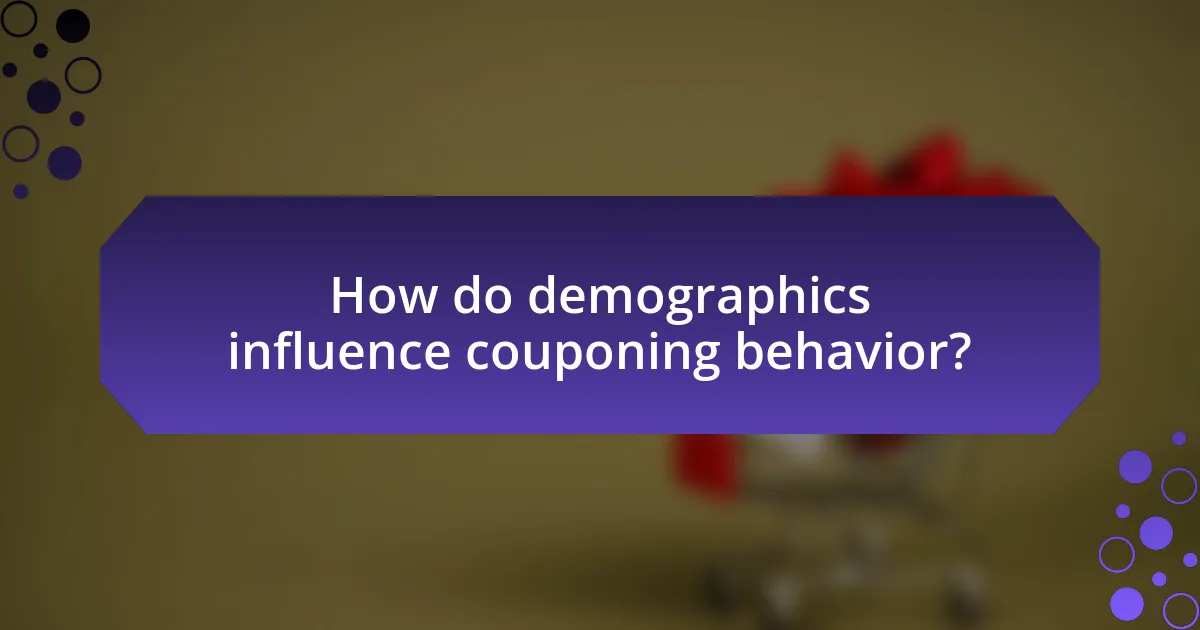
How do demographics influence couponing behavior?
Demographics significantly influence couponing behavior by affecting the types of products consumers seek and their responsiveness to discounts. For instance, younger consumers, particularly millennials and Gen Z, are more likely to use digital coupons and engage with mobile apps, while older demographics may prefer traditional paper coupons. Additionally, income levels play a crucial role; lower-income households tend to be more motivated by savings and actively seek out coupons to stretch their budgets, as evidenced by a study from the Journal of Consumer Research, which found that 70% of low-income consumers use coupons regularly compared to 40% of high-income consumers. Furthermore, family size impacts coupon usage, with larger families often utilizing coupons more frequently to manage household expenses effectively.
What demographic factors affect coupon usage?
Coupon usage is significantly influenced by demographic factors such as age, income, education level, and household size. Younger consumers, particularly millennials and Gen Z, tend to use coupons more frequently, with studies indicating that 68% of millennials actively seek out coupons. Income levels also play a crucial role; lower-income households are more likely to use coupons as a means to save money, with 83% of households earning less than $50,000 annually reporting coupon usage. Education level impacts coupon usage as well, with individuals holding higher degrees often being more strategic in their shopping habits, including the use of coupons. Additionally, larger households tend to utilize coupons more, as they often have greater grocery needs and seek to maximize savings. These demographic trends highlight the varying motivations and behaviors associated with coupon usage across different consumer segments.
How do age and income levels correlate with couponing habits?
Age and income levels significantly correlate with couponing habits, as younger consumers and those with lower incomes tend to use coupons more frequently. Research indicates that individuals aged 18 to 34 are more likely to engage in couponing, with 60% of this demographic reporting regular use of coupons, compared to only 30% of those aged 55 and older. Additionally, households earning less than $50,000 annually are more inclined to utilize coupons, with 70% indicating they use them regularly, while only 40% of households earning over $100,000 report similar habits. This trend suggests that financial constraints and the pursuit of savings drive couponing behavior, particularly among younger and lower-income consumers.
What differences exist in couponing preferences among various demographics?
Couponing preferences vary significantly among demographics, influenced by factors such as age, income, and geographic location. For instance, younger consumers, particularly millennials and Gen Z, tend to prefer digital coupons and mobile apps, while older generations often favor traditional paper coupons. Additionally, higher-income individuals may prioritize premium brands and exclusive offers, whereas lower-income consumers typically seek discounts on essential items. Geographic differences also play a role; urban residents may engage more with online couponing platforms, while rural consumers might rely on local store promotions. Research indicates that 70% of millennials use coupons, primarily through digital means, compared to only 30% of seniors who prefer paper formats. This data underscores the distinct preferences across demographic groups in couponing behavior.
How does technology shape the couponing landscape?
Technology significantly shapes the couponing landscape by enabling digital distribution and personalized marketing strategies. Digital platforms allow consumers to access coupons instantly through apps and websites, increasing engagement and usage rates. According to a study by the National Retail Federation, 97% of consumers use coupons, with digital coupons being the fastest-growing segment, reflecting a shift from traditional paper coupons to electronic formats. This transition not only enhances convenience for consumers but also allows retailers to track consumer behavior and preferences, leading to more targeted and effective promotional strategies.
What role do mobile apps play in modern couponing?
Mobile apps play a crucial role in modern couponing by providing consumers with easy access to digital coupons and personalized offers. These applications enable users to browse, save, and redeem coupons directly from their smartphones, enhancing convenience and engagement. According to a 2021 study by eMarketer, 80% of smartphone users have used their devices to access coupons, demonstrating the widespread adoption of mobile couponing. Additionally, mobile apps often utilize location-based services to deliver targeted local offers, which increases the relevance of promotions and drives consumer spending. This integration of technology and consumer behavior illustrates how mobile apps have transformed traditional couponing into a more dynamic and personalized experience.
How has online shopping influenced couponing strategies?
Online shopping has significantly transformed couponing strategies by shifting the focus from traditional paper coupons to digital formats. This transition allows retailers to offer personalized and targeted discounts based on consumer behavior and preferences, enhancing the effectiveness of couponing. For instance, a study by the National Retail Federation found that 80% of consumers prefer digital coupons over paper ones, indicating a clear trend towards online couponing. Additionally, the integration of mobile apps and websites enables instant access to deals, fostering a more immediate and engaging shopping experience. This evolution in couponing not only increases redemption rates but also allows retailers to track consumer interactions more effectively, optimizing future marketing strategies.
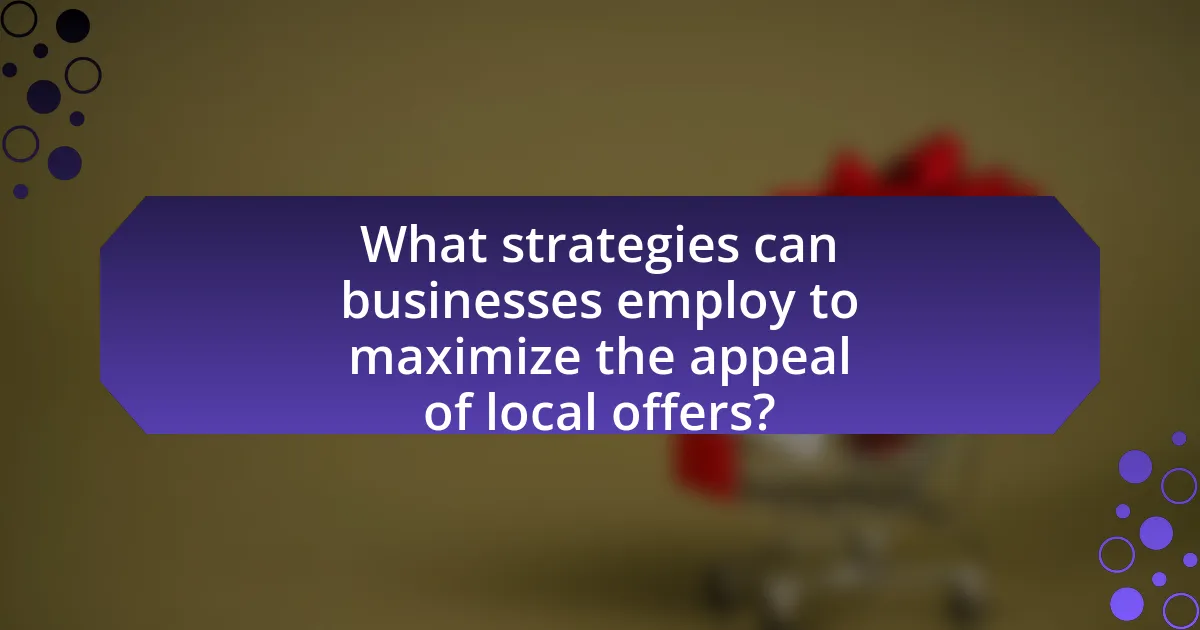
What strategies can businesses employ to maximize the appeal of local offers?
Businesses can maximize the appeal of local offers by personalizing promotions to target specific demographics within the community. Tailoring offers based on local preferences and behaviors increases relevance, as evidenced by a study from the Local Search Association, which found that 70% of consumers prefer personalized marketing messages. Additionally, leveraging social media platforms to promote local deals enhances visibility and engagement, with 54% of consumers reporting they are more likely to engage with brands that offer localized content. Collaborating with local influencers can also amplify reach, as influencer marketing has shown to yield a return on investment of $5.78 for every dollar spent, particularly in local markets.
How can businesses effectively target local consumers with coupons?
Businesses can effectively target local consumers with coupons by utilizing geolocation technology and local partnerships. Geolocation technology allows businesses to send digital coupons to consumers’ smartphones when they are in proximity to the store, increasing the likelihood of immediate redemption. Additionally, partnering with local organizations or events can enhance visibility and credibility, as consumers often respond positively to offers that support their community. Research indicates that localized marketing strategies can increase consumer engagement by up to 30%, demonstrating the effectiveness of targeting local audiences with tailored coupon offers.
What marketing techniques enhance the visibility of local offers?
Local offers gain visibility through targeted marketing techniques such as geo-targeted advertising, social media promotions, and local SEO optimization. Geo-targeted advertising allows businesses to reach consumers in specific geographic areas, increasing the likelihood of engagement with local offers. Social media promotions leverage platforms like Facebook and Instagram to share deals with local audiences, often utilizing location tags and hashtags to enhance discoverability. Local SEO optimization ensures that businesses appear in local search results, making it easier for consumers to find relevant offers. According to a study by Google, 76% of people who search for something nearby visit a business within a day, highlighting the effectiveness of these techniques in driving local engagement.
How can businesses create a sense of urgency around local coupons?
Businesses can create a sense of urgency around local coupons by implementing time-sensitive promotions and limited availability offers. For instance, setting expiration dates on coupons encourages consumers to act quickly to take advantage of the deal, as studies show that urgency can increase conversion rates by up to 30%. Additionally, highlighting limited quantities or exclusive offers can further enhance the urgency, as consumers are motivated by the fear of missing out. This strategy aligns with psychological principles, such as scarcity and time pressure, which are proven to drive consumer behavior effectively.
What best practices should consumers follow when using coupons?
Consumers should follow several best practices when using coupons to maximize their savings and ensure effective use. First, they should always read the terms and conditions of each coupon to understand restrictions, expiration dates, and eligible products. This practice helps avoid confusion and ensures that consumers only attempt to redeem valid coupons. Additionally, consumers should organize their coupons by category or expiration date, which facilitates easier access and prevents missed savings opportunities.
Moreover, consumers should compare prices before using coupons to ensure that the discounted price is lower than the regular price at different retailers. Research indicates that consumers can save an average of 20% on their grocery bills by strategically using coupons in conjunction with sales (Nielsen, 2020). Lastly, consumers should consider using digital coupons and apps, which often provide additional savings and convenience, as they can be easily accessed and tracked.
How can consumers effectively organize and track their coupons?
Consumers can effectively organize and track their coupons by utilizing digital coupon apps and maintaining a systematic filing method for physical coupons. Digital apps, such as Honey or Rakuten, allow users to store and categorize coupons, set reminders for expiration dates, and track savings in real-time. Research indicates that 80% of consumers prefer digital coupons due to their convenience and ease of access, which enhances coupon usage and maximizes savings. For physical coupons, consumers can use a binder with labeled sections or envelopes to categorize coupons by store or product type, ensuring easy retrieval and management. This organized approach not only simplifies the couponing process but also increases the likelihood of using coupons before they expire, ultimately leading to greater savings.
What tips can help consumers maximize their savings with local offers?
To maximize savings with local offers, consumers should actively compare prices and utilize digital coupon platforms. Research indicates that consumers who compare prices can save an average of 20% on their purchases, as they identify the best deals available in their area. Additionally, subscribing to local business newsletters and following social media accounts can provide exclusive discounts and promotions, further enhancing savings opportunities. Engaging with loyalty programs also yields significant benefits; studies show that members of such programs can save up to 15% more than non-members due to targeted offers and rewards.

